MP Board Class 8th Science Solutions Chapter 17 Stars and The Solar System
MP Board Class 8th Science Stars and The Solar System NCERT Textbook Exercises
Choose the correct answer in question 1 – 3:
Mp Board Class 8 Science Chapter 17 Question 1.
Which of the following is NOT a member of the solar system?
(a) An asteroid
(b) A satellite
(c) A constellation
(d) A comet.
Answer:
(c) A constellation.
Mp Board Class 8 Science Solution Chapter 17 Question 2.
Which of the following is NOT a planet of the sun?
(a) Sirius
(b) Mercury
(c) Saturn
(d) Earth.
Answer:
(a) Sirius.
Class 8 Science Chapter 17 Mp Board Question 3.
Phases of the moon occur because
(a) we can see only that part of the moon which reflects light towards us.
(b) our distance from the moon keeps changing.
(c) the shadow of the earth covers only a part of moon’s surface.
(d) the thickness of the moon’s atmosphere is not constant.
Answer:
(a) We can see only that part of the moon which reflects light towards us.
Mp Board Class 8 Social Science Solution Chapter 17 Question 4.
Fill in the blanks:
(a) The planet which is farthest from the sun is ………… .
(b) The planet which appears reddish in colour is ……………….. .
(c) A group of stars that appear to form a pattern in the sky is known as a …………. .
(d) A celestial body that revolves around a planet is known as ……………… .
(e) Shooting stars are actually not …………….. .
(f) Asteroids are found between the orbits of ………… and…………..
Answer:
(a) neptune
(b) mars
(c) constellation
(d) satellite
(e) meteors
(f) mars, jupiter.
Mp Board Class 8 Science Book Pdf Question 5.
Mark the following statements as true (T) or false (F):
- Pole star is a member of the solar system.
- Mercury is the smallest planet of the solar system.
- Uranus is the farthest planet in the solar system.
- INSAT is an artificial satellite.
- There are nine planets in the solar system.
- Constellation Orion can be seen only with a telescope.
Answer:
- False
- True
- False
- True
- False
- False.
Class 8 Chapter 17 Science Question Answer MP Board Question 6.
Match items in column A with one or more items in column B:
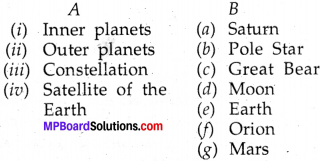
Answer:
(i) (g), (ii) (e), (iii) (c), (f), (iv) (d).
Class 8 Science Chapter 17 MP Board Question 7.
In which part of the sky can you find Venus if it is visible as an evening star?
Answer:
Venus is seen as an evening star in western
Science Class 8 Mp Board English Medium Question 8.
Name the largest planet of the solar system.
Answer:
Jupiter is the largest planet of the solar system.
Class 8 Science Chapter 17 Question Answer MP Board Question 9.
What is a constellation? Name any two constellations.
Answer:
Constellation is a group of stars that appears to form some recognizable shape. For example, Ursa Major and Orion.
Chapter 17 Class 8th Science MP Board Question 10.
Draw sketches to show the relative positions of prominent stars in:
(a) Ursa Major, (b) Orion
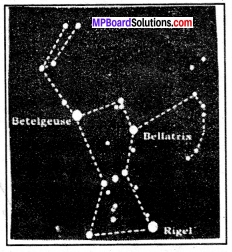
Fig. 17.1: Relative position of stars in Ursa Major and Ursa Minor stars in Orion.
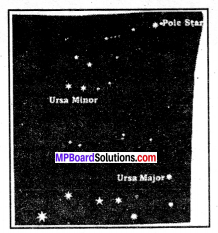
Fig. 17.2: Relative position of stars in Orion.
Star And The Solar System Class 8 MP Board Question 11.
Name two objects other than planets which are members of the solar system.
Answer:
Asteroids and Comets.
Mp Board Class 8 Social Science Chapter 17 Question 12.
Explain how you can locate the Pole Star with the help of Ursa Major?
Answer:
Pole Star can be located with the help of the two stars at the end- of Ursa Major. Imagine a straight line passing through these stars as shown in Fig 17.3. Extend this imaginary line towards the north direction. (About five times the distance between the two stars). This line will lead to a star which is not too bright. This is the Pole Star. Observe the pole star for some time. Note that it does not move at’ all as other stars drift from east to west.
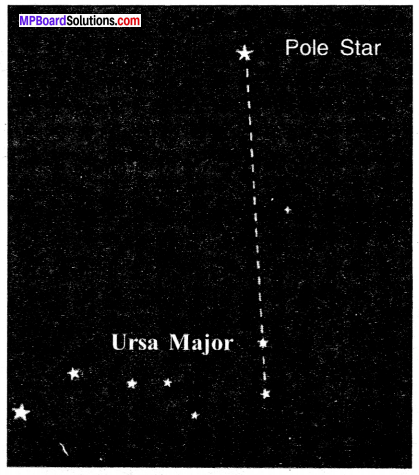
Question 13.
Do all the stars in the sky move? Explain.
Answer:
No, stars actually do not move but they only appear to move from east to west, as the earth from where we see them, rotates from west to east. However pole star, which is situated in the direction of the earth’s axis. It does not appear to move.
Question 14.
Why is the distance between stars expressed in light years? What do you understand by the statement that a star is eight light years away from the Earth.
Answer:
The sun is about 150,000.00 kilometres (150 million km) away from the earth. It is not convenient to express such large distances in kilometres. Therefore, large distances between stars are expressed in another unit known as light near. A light year is the distance ‘r travelled by light in a year.
1 light year = speed of light x number of seconds in a year
= 300,000 x 365 x 24 x 60 x 60km.
= 95,00,00,00,00,000 km = 95 x 1011
= 9.5 x 10 x 1011
= 9.5 x 1012 km (Approximately)
∴ 8 light year
= 8 x 9.5 x 1012 km
= 76 x 1012 km
Thus, by the statement that a star is eight light years away from the earth means that the star is about 76 x 1012 km away from the earth.
Question 15.
The radius of Jupiter is 11 times the radius of the Earth. Calculate the ratio of the volumes of Jupiter and the Earth. How many Earths can Jupiter accommodate?
Answer:
If the radius of the Earth is r.
Then, radius of the Jupiter is Ur.
So, ratio of the volumes of Jupiter and Earth is

Thus, 1331 Earths can be accommodated within the Jupiter.
Question 16.
Boojho made the following sketch (Fig. 17.4) of the solar system. Is the sketch connect? If not, correct it.
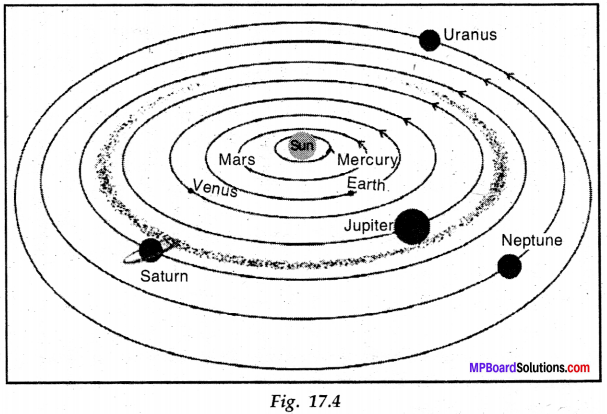
Answer:
This sketch is not correct. The correct sketch of solar system is given is Fig. 17.5.
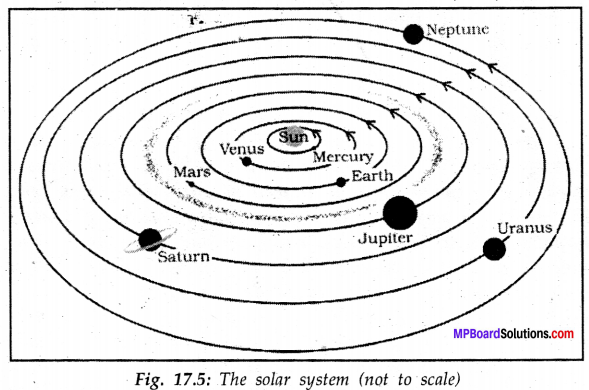
MP Board Class 8th Science Stars and The Solar System Extended Learning – Activities and Projects
Question 1.
The North-South line at your place.
Let us learn to draw the north-south line with the help of the shadow of a stick. Fix a straight stick vertically in the ground where the Sun can be seen for most of the day. Call the foot of the stick as point O. Sometime in the morning, mark the tip of the shadow of the stick. Say this point is A. With OA as radius draw a circle on the ground. Wait till the shadow becomes shorter and then starts increasing in size. When the shadow again touches the circle, mark it as point B. Draw the bisector of the angle AOB. This is your North-South line. To decide which side
of this line shows North, use a magnetic compass.
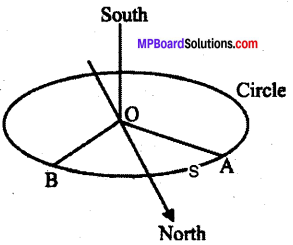
Answer:
Do yourself.
Question 2.
If possible, visit a planetarium. There are planetariums in many cities. In a planetarium you can see the motion of the stars, constellations and planets on a large dome.
Answer:
Do yourself.
Question 3
On a moonless night observe the sky for a few hours. Look out for a meteor, which appears as a streak of light. September-November is a good time for observing meteors.
Answer:
Do yourself.
Question 4
Learn to identify the planets visible to the naked eye and some prominent constellations such as Great Bear (Saptarishi) and Orion. Also try to locate the Pole Star and the star Sirius.
Answer:
Do yourself.
Question 5.
Position of the rising Sun – Uttarayan and Dakshinayan :
This activity may last for several weeks. Choose a place from where eastern horizon is clearly visible. Choose also a marker, such as a tree or an electric pole, to mark the position of the rising Sun. It will be sufficient if you take the observation once every week. On any day, note down the direction of the rising Sun. Repeat this observation every week. What do you find? You would have noted that the point of sunrise changes continuously. From summer solstice (around 21 June), the point of sunrise gradually shifts towards the south. The Sun is then said to be in dakshinayan (moving south). It keeps doing so till winter solstice (around 22 December). Thereafter, the point of sunrise changes direction and starts moving towards north. The Sun is now said to be in uttarayan the equinoxes (around 21 March and 23 September) the Sun rises in the east. On all other days, it rises either north of east or south of east. So, the direction of the rising Sun is not a good guide to determine directions. The Pole Star, which defines North,‘is a much better indicator of directions.
Answer:
Do yourself.
Question 6.
Form a group of students. Prepare a model of the solar system showing the planets, and their relative sizes. For this take a large chart paper. Make spheres representing different planets according to their relative size (Use Table 17.1). Y6u may use newspaper, clay or plasticine to make spheres. You can cover these spheres with paper of different colours. Exhibit your models in the class.
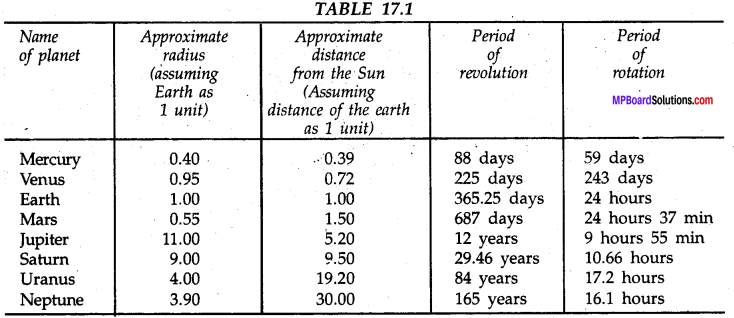
Answer:
Do yourself.
Question 7.
Try to make a scale model of the solar system showing distances of the planets from the Sun (Use Table 17.1). Did you face any difficulty? Explain it.
Answer:
Do yourself.
Question 8.
Solve the following riddle and try to make similar riddles yourself.
My first is in VAN but not in PAN
My second is in EARTH and also in HEAVEN
My third is’ in ONE and not in TWO
My fourth is in BUN and also in FUN
My last is in STAR but not in RADAR
I am a planet that moves round the Sun.
Answer:
It is the planet venus.
MP Board Class 8th Science Stars and The Solar System Additional Important Questions
A. Short Answer Type Questions
Question 1.
What is Universe?
Answer:
Universe is the space surrounding the earth. It contains all the heavenly objects like stars, comets, planets, asteroids, etc.
Question 2.
Name two constellations which are visible in summer.
Answer:
Scorpio and Ursa Major.
Question 3.
What are comets?
Answer:
Heavenly bodies, composed of dust and gas, revolving around the sun with long bright tail are called comets. Their period of revolution around the sun is very large. They are particularly seen, after the pretty number of years.
Question 4.
Which is the brightest planet of our solar system?
Answer:
Venus is the brightest planet of our solar system.
Question 5.
What is the most significant feature of remote sensing technology?
Answer:
The most significant feature of remote sensing technology is that it makes possible the repetitive surveys of vast areas in a very short time. It is applicable even to inaccessible areas.
B. Long Answer Type Questions
Question 6.
Define light year. What is the approximate distance of the sun from the earth?
Answer:
One light year is the distance travelled by light in one year at a speed of light which is about 300000 km/sec. Light year is a unit of distance and is equal to 9.46 x 1012 km.
The approximate distance of the sun from the earth is 150,000,000 km, which means that light takes about 8 minutes 20 seconds to reach the earth from the sun.
Question 7.
The stars twinkle and the planets do not twinkle. Account for the observation.
Answer:
Owing to the atmospheric disturbances in the atmosphere the position of the stars appears to vibrate, so they apear to be twinkling. Due to the fact that the planets are very close to each other, their disc position does not vibrate, owing to the atmospheric conditions, hence the planets do not appear to be twinkling.
Question 8.
Give three reasons why life cannot survive on Venus.
Answer:
All the above conditions are present on the earth. Hence, life is possible there.
- Being nearer to the sun Venus it is extremely hot.
- There is no water on the planet
- The planet does not contain sufficient oxygen.
Question 9.
Expand the term INSAT. What three things are expected from INSAT?
Answer:
The term INSAT stands for Indian National Satellite. This satellite series expected to carry out three tasks. These tasks are:
- communication
- television and radio broadcasting and
- meteorological observations.